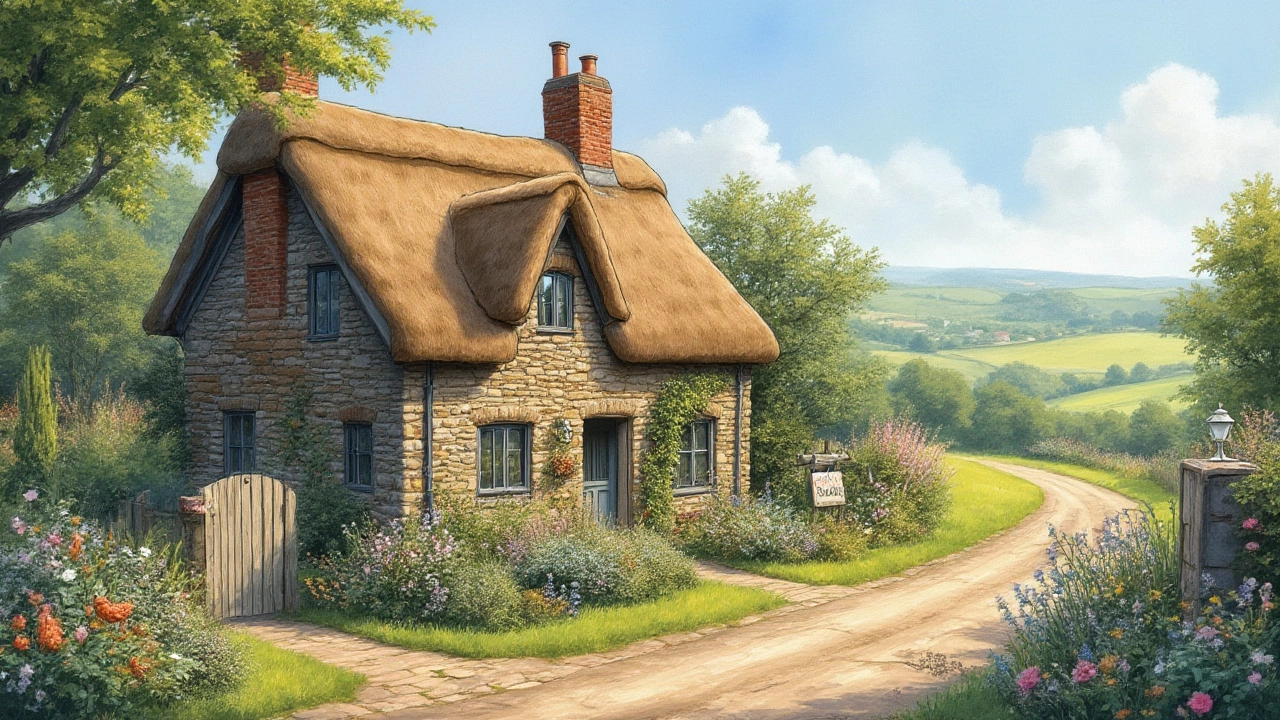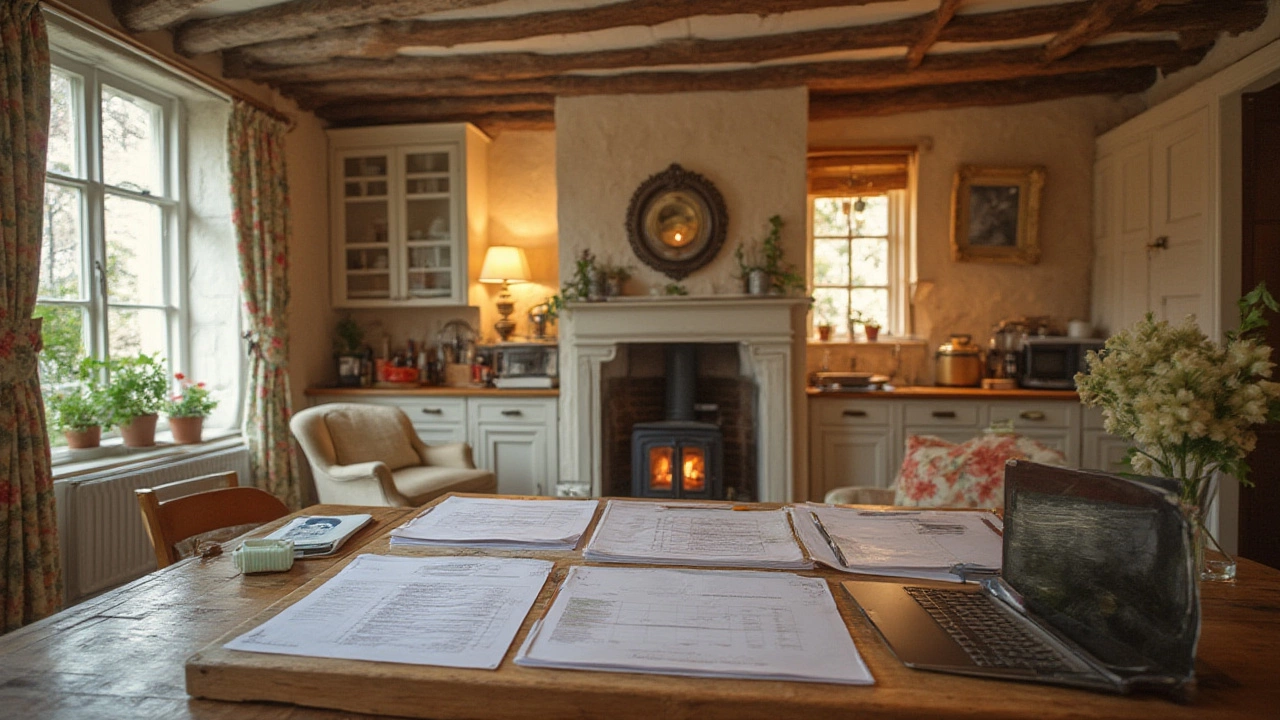How to Make Money with Cottages: Income Tips, Ideas & Real Insights
 Jul, 27 2025
Jul, 27 2025
If someone had told me a decade ago that a sleepy lakeside cottage in the middle of nowhere could out-earn a flashy city apartment, I honestly would have chuckled. Now, it’s July 2025, and my tabby cat Mistral is curled on my lap while I sift through a stack of short-term rental data—and trust me, the numbers are fascinating. People aren’t just making pocket change from rustic retreats; plenty are paying mortgages, funding travel, and yes, even building small empires. The cottage business isn’t just for folks with deep pockets or interior design diplomas.
The opportunity is real, but so are the landmines. Let’s dig into the cheats, hacks, and hard truths: can you make money off cottages in today’s world, or will you wind up with a money pit and a possum for a neighbor?
How Cottage Owners Actually Make Money
So, where’s the real cash hiding in all those timber beams and wildflower meadows? The main way people are getting income from cottages is—surprise—renting them out. Platforms like Airbnb and Vrbo changed the game in the last decade. Nowadays, even a tiny, Instagrammable cottage that looks like an elf’s vacation home can bring in more during summer than a downtown condo. Location is still king, but personality and clever marketing can send bookings through the roof in places you’d least expect.
Take Ontario’s lake region. According to a study published in late 2024 by ShortStay Data Group, an average two-bedroom waterfront cottage there was grossing $28,700 per year in rental income. In Maine, USA, similar properties posted numbers near $25,000—sometimes more if they offered something quirky like a wood-fired tub or a themed shelter for yoga lovers. Not all profit, but after mortgage payments and essentials, owners were walking away with $8k–13k of annual net income, often by doing their own cleaning and repairs.
There’s also a market for longer-term stays. Writers seeking solitude for their novels, freelancers running away from city noise, people on gap years—these folks book months at a time, even off-season. If you’re flexible about how long you’ll let someone rent your place, you’ll fill gaps and dodge that awkward “dead season” where nothing seems to move.
Another, slightly less obvious, income stream is photo or film shoots. In 2023, a tiny Scottish-style cottage near the Yorkshire moors raked in £7,500 from just three days rented to a toothpaste commercial crew. Planners and agencies troll Instagram for unusual spaces. If your cottage has a rare feature—a treehouse, a quirky mural, a heart-stopping view—you can land these gigs without too much hustle. Agencies like Peerspace or Giggster make this easier than ever.
Some folks get creative by hosting events—yoga weekends, foraging workshops, or even writer’s retreats. While it sounds dreamy, these gigs require brilliant insurance, permits, and patience with complicated guests. The upside? Each small event can charge $200–$500 per head, and people will pay if you throw in scones and local honey.
Here's a quick breakdown of potential cottage income sources for you:
| Income Source | Potential Annual Earnings |
|---|---|
| Short-term Rental | $15,000–$35,000 |
| Long-term Rental | $10,000–$20,000 |
| Event Hosting | $2,500–$15,000 |
| Photo/Film Location | $2,000–$12,000 |
Now, none of this comes without tradeoffs. Cottages demand hands-on love that hotels don’t. You’ll scrub mildew, wrangle malfunctioning hot tubs, or, in my case, chase out the occasional bat when the weather turns. But for many, the balance tilts toward profit—especially as rural getaways become rarer and more people ditch urban chaos for nature escapes.
- Maximize your photos: Beautiful, well-lit pics book rooms. Add quirky details—fairy lights or an unusual lamp goes a long way.
- Write creative, detailed listings: Say more than “cozy two-bed.” Show off the reading nook or creek view.
- Make it pet-friendly: A third of travelers look for places that accept pets. You can even charge a little extra.
- Lean into eco-friendly features: Solar panels or composting loos impress guests and push you up search rankings on niche platforms.
- Respond to messages fast: If you’re sleepy at 11:45 PM and get a question, answer anyway. Quick replies have been shown to increase bookings by as much as 18% (Airbnb Host Insights, 2024).

What Does It Really Cost to Run a Cottage?
Plenty of would-be hosts picture vacation property as a “set it and forget it” investment. I wish it were that simple. The truth? Cottages eat cash unless you keep a tight grip on costs. Of course, it’s much more chill than raising toddlers or launching a startup, but still—don’t be fooled by Instagram’s endless sunsets and jars of wild-picked daisies.
The first thing to reckon with: startup expenses. Buying a cottage isn’t usually cheap. In the UK, the average price for a two-bedroom in a scenic area hit £285,000 in late 2024, rising to £340,000 for lakefront spots. In the US and Canada, numbers swing wildly, but you’ll rarely find something charming for under $200,000. Repairs add up—think roof leaks, old boilers, pest control, and all those little details city apartments don’t usually demand.
Next up, recurring costs. If you’re thinking, “I’ll just charge a big cleaning fee and pocket the rest!” you might be surprised. Cleaners in tourist hotspots can charge £120 or $160 per visit. Lawn, garden, and snow removal can set you back $1,800 per year. Municipal taxes on short-term rentals climbed in the last two years (part of a worldwide trend to control what locals see as ‘Airbnb-ification’). Expect to pay 10–14% in taxes on income, plus compliance and licensing costs, which can chew through several thousand dollars per year if your place is in a regulated area like Lake Tahoe or Cornwall.
Then there’s insurance. “Cottage” is code for “all kinds of weird damages.” Storms take out branches, pipes freeze in winter, and occasionally, a guest’s dog mistakes your Persian rug for a toilet. Specialized short-term rental insurance—cheaper than letting your standard policy lapse—costs $800–$1,300 per year but can save your bacon.
Of course, smart hosts cut costs where they can. Some prune landscaping themselves (shout-out to my friend Charlie, who runs his eco-cottage in Devon with a battery lawnmower he calls “Beastie”). Others swap linens directly with cleaners on changeover days to avoid laundry delivery fees.
Here are some of the usual (sometimes surprising) annual costs for a typical cottage rental setup:
| Expense | Typical Annual Cost |
|---|---|
| Cleaning | $1,500–$5,000 |
| Utilities | $1,200–$2,800 |
| Taxes & Licensing | $2,000–$7,500 |
| Insurance | $800–$1,300 |
| Maintenance/Repairs | $1,000–$3,000 |
You can see how expenses pick at your profit. This is why most successful owners I know keep an “emergency fund”—usually $2k–$5k—to tackle those oh-no moments.
If you’re looking for ways to squeeze more profit, here are a few life lessons from the field:
- Do minor repairs yourself—YouTube can teach almost anyone to fix a running toilet or repaint a picket fence with surprisingly professional results.
- Automate with smart locks and thermostats—Guests love them, and you’ll spend less time running back and forth (and lower heating bills by 8–10%).
- Partner with local businesses for services—Barter a small discount for repeat business with grill-cleaners, plumbers, or handymen who live nearby.
- Invest in durability—Buy plates, sheets, and pans that take a beating. Cheap stuff breaks, and midnight trips to IKEA are nobody’s idea of passive income.
- Be upfront with guests—If there’s no WiFi, say so. Guests who know what to expect leave fewer bad reviews and usually treat the place better.
Getting to the black (not just breaking even) will hinge on how much effort you’re really willing to give. If you’re away or have a demanding day job, consider professional managers—but remember, they take 15–25% of your booking fees.

Tips for Standing Out and Maximizing Your Cottage Income
Thousands of new cottages hit the rental market every year. Back in 2020, you could be the only game in a ten-mile stretch. Now, even the tiniest hamlets have competition. So, you’ll need to get savvy to stand out. Here’s how to move from “I hope someone books” to “Why do I have a waitlist?”
Your listing is the dealmaker (or breaker). A study by Lodgify in late 2024 found that cottage ads with staged professional photos booked 33% more nights. If you can swing a pro shoot for £300, it often pays back within weeks. Show the view, highlight quirky details—think barn doors, lakeside hammocks, or a reading corner that looks like something out of a fairy tale.
Furnishings matter, but not in the way most people think. Skip expensive designer pieces; focus on comfort and story. A set of mismatched mugs from local potters, cozy wool throws, or a homemade picnic basket kit creates Instagram bait. People pay extra for places that feel like a scene from a movie rather than a cookie-cutter hotel.
Storytelling sells, both in your property and your online profile. Tell guests why you love the place—maybe it’s the morning birdsong, or the way the wind rattles the old shutters during a spring storm (my cat Mistral hates this, but city guests seem charmed by it). Mention the wildlife (but not the spiders if your guests may be squeamish!). Brag about nearby secret beaches or local cheesemakers if you can.
Think about who’s coming and tweak your pitch. City workers? Show fiber internet and a sturdy desk. Pet owners? Mention long trails and a spill-proof, dog-friendly sofa. Young families? Safety plugs, cot, board games galore. Each detail nudges you higher in the search ranks.
Don’t be a ghost host. According to a 2024 Airbnb survey, hosts who replied to bookings or questions within one hour saw 17% higher occupancy rates. Automated templates help, but adding a little personality (“Yes, the porch really does get foxes at sunrise!”) works wonders.
Seasonality is a beast with cottages. Don’t pack up and ghost guests from November to March. Offer deep discounts for midweek, off-season stays (think: leaf peepers, winter writers, or those who crave solitude). Try partnering with local guides or businesses—think wild foraging excursions, canoe rentals, or farm-fresh breakfast deliveries. Splitting profits or sharing traffic helps everyone get more bookings.
I’ve also seen owners bundle experiences: “Book three nights, get a local gift basket” or “free snowshoe rental for two.” These tiny add-ons increase bookings much more than slashing nightly rates.
No article is complete without mentioning reviews. They are pure gold. Solicit feedback with grace—thank every guest, and respond calmly even to the odd grumble about a tricky wood stove or noisy owls. A good host reputation can let you raise nightly rates year over year and spend less on advertising.
- Refresh your listing every few months to stay in search rotation.
- Experiment with pricing—higher on holidays, lower on midweeks, and watch for sweet spots.
- Test niche platforms, too—outdoorsy ones like Hipcamp and eco brands can fill dates mainstream sites miss.
- Keep a guestbook—digital or physical—and mention your favorite local spots.
- Show real hospitality—a handwritten note or home-baked cookies cost little but go viral in guest stories.
So, does making money off cottages mean you’ll quit your day job and buy a yacht? Maybe not overnight. But with authentic hospitality, shrewd spending, and a sprinkle of personality, you’ll have your own slice of countryside wealth—and likely a fun story or two for your next dinner party. Now, if you’ll excuse me, I have to stop Mistral from eating (another) Airbnb welcome basket.